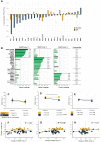Caloric Restriction Intervention Alters Specific Circulating Biomarkers of the Senescence-Associated Secretome in Middle-Aged and Older Adults With Obesity and Prediabetes in an 18-Week Randomized Controlled Trial
- PMID: 37738560
- PMCID: PMC10733170
- DOI: 10.1093/gerona/glad214
Caloric Restriction Intervention Alters Specific Circulating Biomarkers of the Senescence-Associated Secretome in Middle-Aged and Older Adults With Obesity and Prediabetes in an 18-Week Randomized Controlled Trial
Abstract
Cellular senescence is a biological aging process that is exacerbated by obesity and leads to inflammation and age- and obesogenic-driven chronic diseases including type 2 diabetes. Caloric restriction (CR) may improve metabolic function in part by reducing cellular senescence and the pro-inflammatory senescence-associated phenotype (SASP). We conducted an ancillary investigation of an 18-week randomized controlled trial (RCT) of CR (n = 31) or Control (n = 27) in 58 middle-aged/older adults (57.6 ± 5.8 years; 75% Women) with obesity and prediabetes. We measured mRNA expression of select senescence and apoptosis genes in blood CD3 + T cells (qRT-PCR) and a panel of 25 plasma SASP proteins (Luminex/multiplex; ELISA). Participants randomized to CR lost -10.8 ± 0.9 kg (-11.3% ± 5.4%) over 18 weeks compared with +0.5 ± 0.9 kg (+0.03% ± 3.5%) in Control group. T-cell expression of senescence biomarkers, p16INK4a and p21CIP1/WAF1, and apoptosis markers, BCL2L1 and BAK1, was not different between CR and Control groups in age, race, and sex-adjusted mixed models (p > .05, all). Iterative principal axis factor analysis was used to develop composite SASP Factors, and the Factors comprising TNFRI, TNFRII, uPAR, MMP1, GDF15, OPN, Fas, and MPO were significantly altered with CR intervention (age, sex, race-adjusted mixed model time × treatment F = 4.17, p ≤ .05) and associated with the degree of weight loss (R2 = 0.12, p ≤ .05). Our study provides evidence from an RCT that specific circulating biomarkers of senescent cell burden are changed by CR in middle-aged and older adults with obesity and prediabetes. Future studies compare tissue and circulating levels of p16INK4a and pro-inflammatory SASP biomarkers in other populations, and interventions.
Keywords: Aging; Biomarkers; Cell senescence; Dietary restriction; Inflammation.
© The Author(s) 2023. Published by Oxford University Press on behalf of The Gerontological Society of America. All rights reserved. For permissions, please e-mail: journals.permissions@oup.com.
Conflict of interest statement
N.M. is a cofounder of Sapere Bio, holds equity in the company, and is an inventor of intellectual property applications. The other authors declare that the research was conducted in the absence of any commercial or financial relationships that could be construed as a potential conflict of interest.
Figures


References
Publication types
MeSH terms
Substances
Grants and funding
LinkOut - more resources
Full Text Sources
Medical
Research Materials
Miscellaneous

